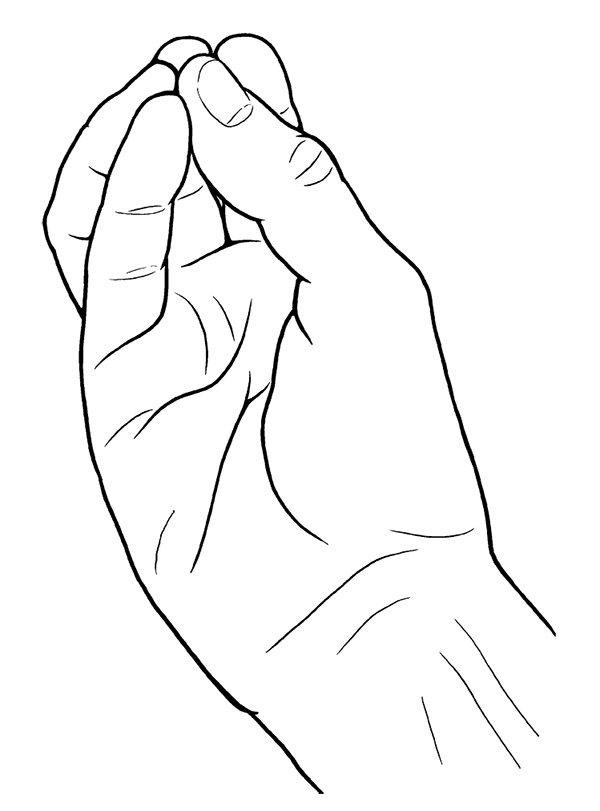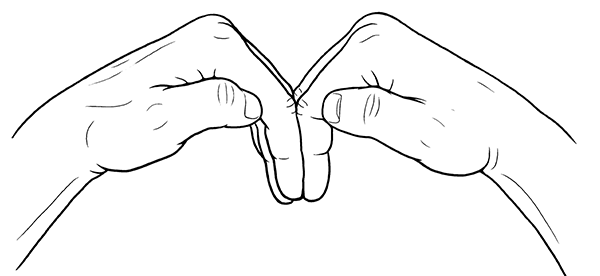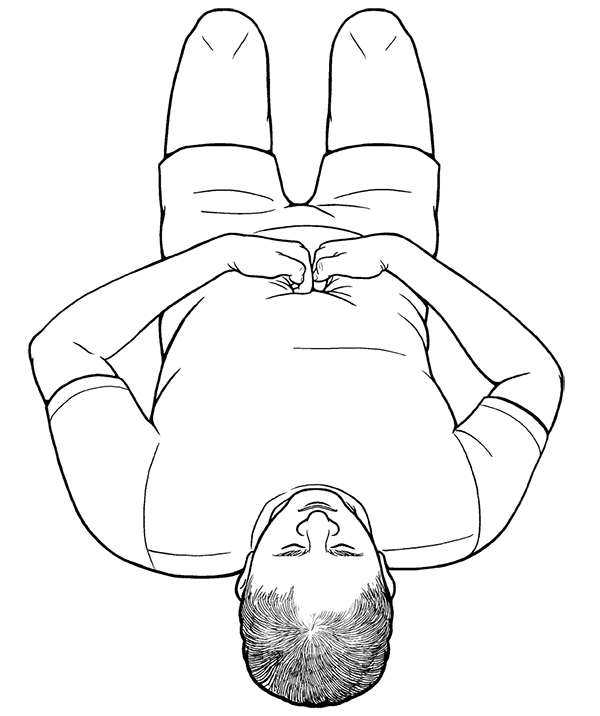Abdominal/Internal Organ Massage
Abdominal massage is a very large topic, and entire books have been devoted to it. At professional levels, it can takes many weeks of training to get acquainted with just the basics, and months or years to master. In part, it’s because the abdomen contains all major internal organs (except the heart and lungs): liver, gall bladder, stomach, spleen, pancreas, kidneys, urinary bladder, and large and small intestines. Thus, so much of the body’s overall health and functionality are affected. It contains the lumbar and lower thoracic regions of the spine and the related nerves that enter and exit the spine at those levels. While it may be difficult to believe, the front of that part of the spine can be accessed in some deep massage practices. The abdomen is also an access region for a major nerve plexus (the solar plexus), located just below the breastbone, as well as for lymphatic vessels and tissues and blood vessels, including the aorta, one of the major arteries exiting the heart.
In Chinese energetics, the abdomen contains the lower Dantian, the energy center that influences everything to do with physicality. In Japanese energetics it is the seat of the hara (translated as “center”), similar to the Dantian in location and function but with slightly broader medical applications, commonly used diagnostically in Japanese acupuncture and acupressure. Depending on the type and purpose of abdominal massage, most or all of these things need to be taken into account.
Here are a couple of practices that are safe for anyone, easy to learn, and effective for what they are designed to do. While you don’t need to know much anatomy, a little familiarity is helpful and will be provided.
The first practice is the more physical of the two, and has a few variations. The primary method presented is best suited for people with healthy to underactive digestive and eliminative functions (having less than one to up to three normal bowel movements a day). It improves digestion and elimination, tones the gastrointestinal system, brings more blood into all the abdominal organs, disperses areas of congested blood, body fluids, and other toxic accumulations, improves breathing, and with some practice assists in improving organ mobility (the springiness of the organs and the suspensory ligaments to which they are attached) and organ motility (the natural rhythms and pulsations generated by and within each organ, indicating its vitality and healthy functionality).
Lie on your back on a mat, on a thick rug on the floor, or on a firm mattress. You can keep your legs extended normally, or bend your knees and place your feet flat on the floor. Many people prefer the bent-knee position because it naturally releases tension in the abdominal muscles, allowing for a more comfortably deep massage.
Next, decide if one massaging hand alone or both together will work best for you. If your fingers are strong and free of pain, you can use one hand in this practice. In that case, either compress your fingers together side by side for support, or wrap the tips of your four fingers around the tip of your thumb so that the tips of all fingers are touching the thumb, with no one fingertip protruding farther than the others (Fig 10.1). This is a hand position used in the Chinese massage practice of tuina, and it is also the beak or whip hand used in the taiji posture Single Whip. If your fingers are not very strong, or if you have joint pain in your fingers or want a deeper massage, you can use two hands in this way. Place the backs of the fingers of each hand together, again with no finger protruding farther than any of the others, so that you have two rows of four fingers at roughly the same height (Fig 10.2).
Now, using one or both hands, place the tips of your fingers just below your belly button (Fig 10.3). Press straight down toward the floor, to whatever depth feels comfortable to you. Make small clockwise circles. Do not let your fingers slide over the surface of your skin, but direct the force downward so that the muscles and internal organs just below your fingertips move in that small clockwise circle. Do this for just a few seconds. Next, partially release the pressure, and slide your fingertips clockwise, a bit to the right and slightly upward, reapply full pressure, and make the small clockwise circles. As you continue this pattern (straight pressure downward, small clockwise circles, release some of the pressure, move your hand to the next location clockwise, reapply full pressure, etc.), your hand(s) will circle your entire belly button in a clockwise circle. The internal organ primarily affected in this circle is the small intestine.
When you arrive at your starting point, closing the large clockwise circle, move your hand slightly lower below your belly button, and repeat all of the above, making a larger clockwise circle around your belly. The small intestine is still influenced in this circle. Consider your starting position below your belly button as 6 o’clock. From the 8 o’clock to 4 o’clock positions, you’re also influencing the large intestine. Depending on the size of this circle, women may find their ovaries at the 7–8 o’clock and 4–5 o’clock positions. While light massage is beneficial to the ovaries, avoid deep massage with strong pressure on them. Between the 7 and 5 o’clock positions, the upper border of the uterus can be felt. Massaging the uterus is always beneficial, and is often very effective in relieving menstrual cramps. At roughly the 3 and 9 o’clock positions—at the sides of your belly slightly above the height of your navel—your fingers will be over the front of your kidneys. They are closer to the back of your body, but for people who are very thin, or for people who are able to comfortably use deep pressure, you may feel a firmness or hardness at that location, about the size of your fist. Those are your kidneys. Light to moderate pressure on them is okay, as long as that pressure does not produce pain. The kidneys are fairly delicate organs, and you should never use strong pressure on them. If you don’t feel your kidneys, that’s fine too. The wave motion you send through your body by the circling massage will still reach them and be beneficial.
When you arrive at your starting point again, repeat all of the above once more, making the largest circle around your belly. Begin just above the center of your pubic bone. The urinary bladder is located there, so you may be more comfortable if you void your bladder before beginning this massage. Women will find the main body of the uterus here as well. In this circle, you will be accessing the large intestine along the sides of your belly and below your ribs. This time, make sure your fingertips contact your ribs during the upper half of the large circle, and direct some of the fingertip pressure under your ribs. That will directly massage your liver and gall bladder (just below your ribs on the right side of your abdomen), and your stomach, which is below your ribs near the middle on the left of your abdomen. To some extent it will indirectly (for most nonprofessional self-massagers) influence your spleen and pancreas, also on the left. Your pancreas is just behind your stomach and to the left, and your spleen is farther to the left and slightly lower.
To benefit your diaphragm, which is also a muscle that responds to massage like other muscles, try to hook your fingers under your ribs so you can massage the inner surface of the ribs. This is near where the diaphragm attaches to the front of your body, and massaging here will relax your diaphragm, allowing for fuller, deeper breathing. For most people, it will be easiest to do this at your lowest ribs near the sides of your belly, and will get more difficult and sensitive as you approach your midline below your breastbone, where more muscle attachments and the solar plexus create more tension. With practice, you will be able to open that middle region more. Don’t force it; be gentle but diligent. When you arrive at the center of your pubic bone once more, that ends the general abdominal massage.
The first variation is for people who typically have more than three bowel movements a day, or chronic loose bowels or diarrhea. Frequently these people also have low energy or fatigue, have a poor appetite, and may feel chilled easily. This variation is performed exactly like the general massage, except that the direction of both the small fingertip circles and three larger circles are done in a counterclockwise direction. Some get better results starting with the large circle, fingertips just above the pubic bone, the second two circles getting gradually smaller, ending with fingertips just below the navel. In addition to reducing the activity of the intestines, that way brings more qi to the center, the Dantian, helps to build energy. Experiment to see what works best for you. In either case, over time you should see an improvement in bowel function, especially when including other exercises from this book in your daily practice.
The next variation is for people who experience some discomfort, including mild to moderate pain when doing the abdominal massage. This is not uncommon, and usually is no cause for concern. You may encounter areas of pain, tenderness, or hardness. That discomfort can be caused by a variety of factors, including simple qi stagnation, gas, bowel obstruction or fecal impaction, tension in the diaphragm, or muscle tenderness from exercise, injury, or a deep spasmed muscle. Many people feel physically, emotionally, or psychologically vulnerable around the abdomen, and they may guard or armor that part of the body unconsciously. When that guard is penetrated, even by oneself, it can be uncomfortable or painful. There is a possibility of pain indicating something more serious, like an inflamed appendix, an aortic aneurysm, diverticulosis, gall or kidney stones, or other internal organ disease, but usually those more serious conditions will present with significant pain and other symptoms. They need to be treated by your physician. If you’re at all in doubt, seek professional medical advice. The massage as described here will not cause any serious problems, but will only shine a light on a problem that already exists. Otherwise, in the absence of serious pain, in this variation work on those uncomfortable areas a little longer than the other more comfortable areas. Being careful not to apply so much pressure that you increase any pain or discomfort you feel, massaging longer will gradually disperse that discomfort, indicating that the underlying condition causing the discomfort is being resolved. This may not happen all at once. Keep track of the location of the discomfort, and over a number of days or weeks, see if it lessens or changes location. Either can indicate an improvement in the underlying condition. If your belly is very relaxed, remember that it’s possible to contact the front of your spine along the midline of your belly, and the hardness you may encounter in that case is normal.
The second practice uses very light touch and is primarily energetic in nature. As in the abdominal massage, there are a couple of variations you can try. In all methods, begin by rubbing your hands together until the palms are warm. This brings blood to your palms, and blood carries qi. The Chinese medical phrase “blood is the mother of qi” means that qi grows out of and is carried by blood. In these energetic practices, you want to have as much qi in your hands as possible to get the best results.
The basic practice follows the same general pattern as the abdominal massage above. That is, you are going to make a large clockwise circle around your abdomen. After you’ve warmed your hands by rubbing them together, place your right palm on the right side of your belly, and your left palm on the left side. Feel for the warmth penetrating your skin, and see if you can follow that warmth more deeply inside your body. Use your mind as much as your physical sensitivity to accomplish this. Then, keeping that sense of deep penetration under your hands as best you can, circle both hands in a clockwise circle around your belly. Only one hand will be able to remain in contact for the entire circle, and it doesn’t matter whether you choose the left or right, but for this description we’ll select the right hand. In a clockwise circle, your right hand will move up and then to the left under your ribs as your left hand moves down and to the right. When your right hand nearly reaches the 9 o’clock position, your left hand will nearly reach the 3 o’clock position. At that point, lift your left hand and let it lightly brush over your right wrist as you continue the circle, keeping your right hand in contact with your belly at all times. As soon as your left hand crosses your right wrist, let it once again contact your belly. When you get good at this practice, the energetic connection from your left hand to your belly will not break, even though the physical connection does. To help maintain good digestion and elimination, do a minimum of twelve circles per day. There is no set upper limit of repetitions for this practice, so if you enjoy it feel free to do as many as you’d like. As your hands pass over all the organs discussed in the abdominal massage practice, this benefits all of those organs energetically.
There are a few ways to practice the next variation, but they all have in common a downward focus on the centerline of your body, so you will only need to learn one method to accomplish that. Stomach qi naturally wants to descend. It does its job of breaking down proteins and turning everything you eat into a soupy liquid, and then sends that down into the small intestine for further digestion. Sometimes, though, a person may overeat, eat something that disagrees with them, drink too much alcohol, get emotionally upset, or become ill, and then the stomach qi moves upward, in the wrong direction. The Chinese call this rebellious qi. Common symptoms include belching, acid reflux, nausea, and in extreme cases, vomiting. This is a practice to restore the normal flow of stomach qi and alleviate those distressing symptoms.
As in the basic practice, warm your hands and place them on the sides of your belly. Using your mind, feel the warmth penetrate your body deeply. This time you will not make clockwise circles. Instead, move both hands upward along the side of your belly, and circle to the midline only, one hand on your breastbone, and one just below it on your solar plexus. It does not matter which hand is in either position. Then slide your hands down the midline of your belly, one hand staying above the other. Use your mind even more to encourage the downward flow of qi while moving your hands downward. Move both hands to just below your navel and part them, right hand moving right and left hand moving left. Again circle up the sides of your belly, minimizing the energetic connection during the upward movement, until your hands once again reach your breastbone and solar plexus. Repeat as many times as is necessary for you to feel some relief and restore the sense of normal descending stomach qi.
 Figure 10.1 (The Physical Practice)
Figure 10.1 (The Physical Practice) Figure 10.2 (The Physical Practice)
Figure 10.2 (The Physical Practice) Figure 10.3 (The Physical Practice)
Figure 10.3 (The Physical Practice)